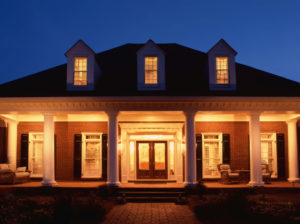It’s a good idea to continually assess the safety and security of your parish or school premises. We’ve compiled the following tips for your review.

Building Perimeter
Break-ins often occur because a building appears to be easy to access or looks “inviting” to a criminal. To look for areas that need improvement, first walk around the perimeter of your facility and assess the following areas:
Look for easy access points into any buildings, specifically focusing on doors, windows and locks. If any of these are faulty, they should be replaced immediately.
Keep bushes and shrubs near your building trimmed; this will eliminate hiding places in the shadows. This will also allow your building to be more visible from the street, which will make noticing suspicious activity easier.
Adequate lighting on your premises is essential and will prevent criminals from lingering too close to your building. Consider using motion-activated lights, which call attention to any movement outside your building.
Make sure there are no accessible ladders, tools or other objects that could assist a burglar with a break-in.
Make sure all valuables are stored away from access points. Criminals are frequently enticed to break in if there are expensive items, such as electronic equipment, visible from a window.
Interior Considerations
Protecting your building from the inside is equally important:
- Adequate lighting inside your building will help keep those using your building safe and will serve as an additional deterrent to criminals. This is particularly important when staff or volunteers are using your facilities after hours.
- Make sure expensive items such as laptops and other electronics are always secured, especially when visitors are inside your building.
- Having a safe to hold money and important documents, especially financial documents containing account numbers, will provide an additional level of security.
- Keep an inventory of property, including serial numbers of computers and other electronic devices. This can help identify theft quickly and will aid in reporting missing items.
- Take preventative measures when your facility is not in use. An alarm system is a wise investment. Often just knowing that a building is outfitted with an alarm serves to deter break-ins. Video cameras also serve to deter criminals and will aid in prosecution if a crime is committed.
Outside Groups
Religious institutions are frequently used by outside organizations for meetings and private functions. Although this can be a source of revenue for organizations, precautions should be taken to ensure that you aren’t putting your property at risk by opening your facility to others. Make sure those using the building are aware of which areas they have access to, and which are restricted. To help reinforce this, lock the doors of all classrooms, offices and other areas of the building when not in use.
Minimize duplicating keys to your building and always maintain a log of who has key access. Instead of offering keys to each group using the facility, ask a representative from your church or organization to open and lock the building for other groups. In this way, control can be maintained and unnecessary duplication of keys can be avoided. This same representative can monitor the building during use to ensure that guests are using the facility in an appropriate manner.
All employees should be well-versed in these security procedures and lock-up routines to ensure consistency. If a key is lost, or your organization undergoes personnel changes, consider changing the keys immediately so that only those who need entrance to your facility are granted access.
Finally, ask for help. Often, local law enforcement can tour your facility for little to no cost and provide additional suggestions for improving your building security. Ask those connected with your organization for help as well. Encourage parents, parishioners and neighbors to report suspicious activity or anything that seems out of place. This can include anything from seeing someone unfamiliar around the premises to noticing a faulty light or lock. The more help our organizations have protecting their properties, the safer they will become.

